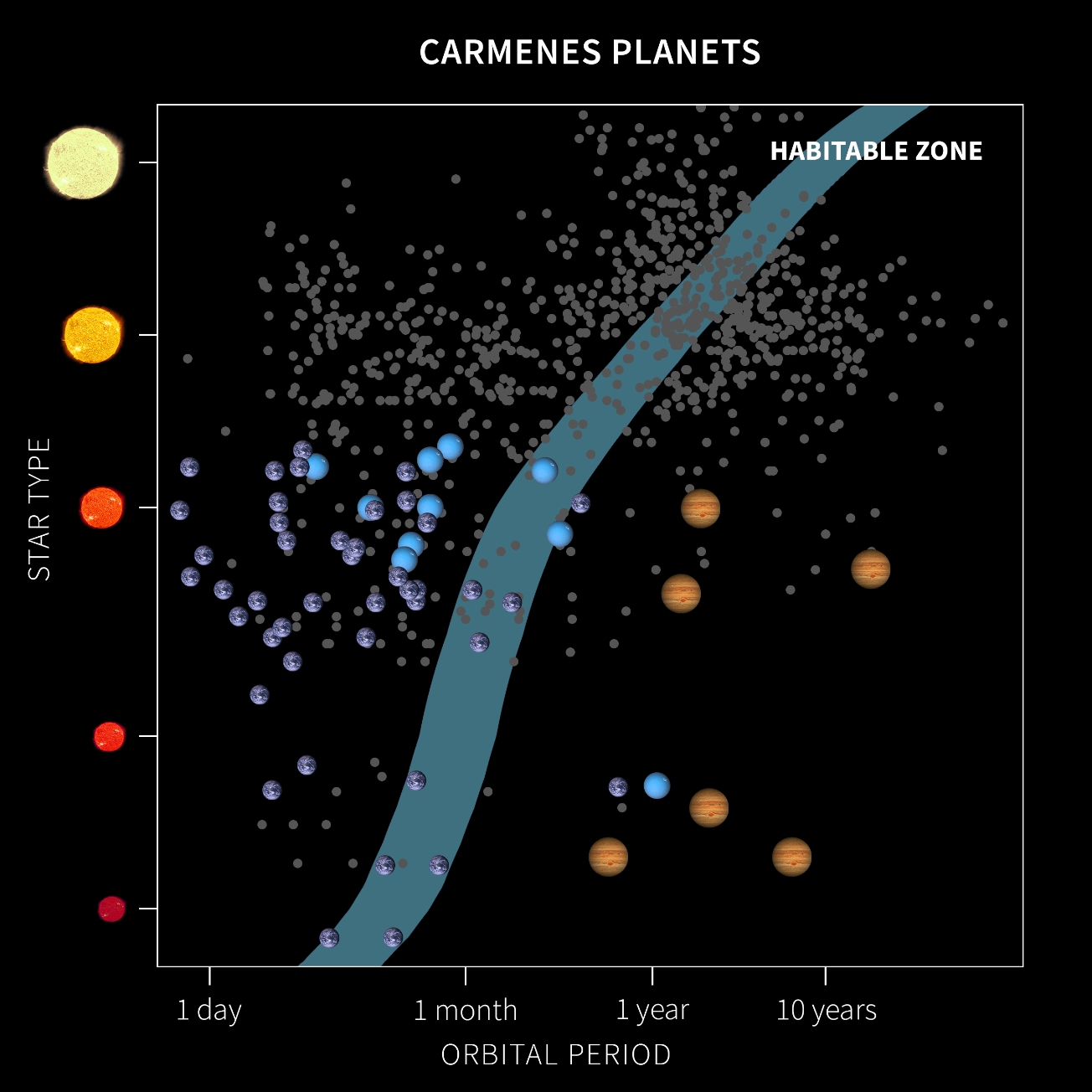CARMENES instrument multiplies the number of known planets in the solar neighborhood
Twenty thousand observations of CARMENES, obtained from the 3.5-meter telescope of the Calar Alto Observatory (CAHA) are made public. The instrument, co-developed by the Institute of Astrophysics of Andalusia (IAA-CSIC), has made it possible to discover 59 planets, some of them in the habitable zone
The CARMENES project consortium has just published the data corresponding to some twenty thousand observations taken between 2016 and 2020, from a sample of 362 nearby cold stars. The instrument, which operates from the 3.5-meter telescope of the Calar Alto Observatory, focuses on the search for exoplanets similar to Earth (rocky and temperate) with the possibility of harboring liquid water on the surface if they are in the habitable zone of the star. Among the multitude of data released, those that have allowed the discovery of 59 exoplanets, a dozen of them potentially habitable, stand out. The results are published in the journal Astronomy & Astrophysics.
"Since it came into operation, CARMENES has reanalyzed seventeen known planets and has discovered and confirmed 59 new planets in the vicinity of our Solar System, contributing notably to expanding the census of nearby exoplanets", says Ignasi Ribas, a researcher at the Institut de Ciències de l'Espai, (IEEC-CSIC) that heads the article.
In fact, this instrument has multiplied the number of exoplanets we know of around nearby cool stars. This first data release will allow its open use to the international scientific community, which will increase the scientific production of CARMENES, which has observed practically half of all nearby small stars (a part of them can only be observed from the southern hemisphere). In addition, the spectra obtained also provide valuable information about the atmospheres of stars and their planets.

The article published in Astronomy & Astrophysics is precisely the hundredth number of the CARMENES consortium, which shows the success of the project. In this study, the data corresponding to the information obtained in visible light have been released, and a second data release will take place in the future with the measurements in the infrared.
The CARMENES project continues through CARMENES Legacy-Plus. Co-led by the IAA-CSIC and the ICE-CSIC, it is the natural continuation and extension of the successful observations with the instrument, which have accumulated almost eight hundred useful nights of observation during five years. It is intended as an exhaustive monitoring to detect and characterize its exoplanets for three hundred nights.
“In addition to the scientific project, from the IAA-CSIC, and in close collaboration with the technicians and engineers of the Calar Alto Observatory, we are developing a technical improvement to provide more precision to the entire instrument, and in particular to the infrared channel. Called CARMENES-PLUS, this instrumental project will allow CARMENES to maintain its high competitiveness, not only broadening its search for rocky planets but also allowing the characterization of their possible atmospheres, which constitutes the next observational challenge in the field”, highlights Pedro J. Amado, IAA-CSIC researcher who coordinated the development of the CARMENES infrared arm and heads CARMENES-PLUS.
A UNIQUE INSTRUMENT
CARMENES uses the radial velocity technique, which searches for tiny oscillations in the motion of the stars generated by the attraction of the planets that revolve around them. And it does so around red dwarf stars (or M dwarfs), smaller than our Sun, which offer the conditions for the existence of liquid water in close orbits and in which, unlike those of the solar type, we can detect the oscillations produced by planets similar to ours with current technology.
CARMENES is a unique instrument in the world, both in terms of precision and stability, essential qualities for measuring the small speed variations that a planet produces in the stars: CARMENES detects speed variations in the movement of stars located hundreds of billions of kilometers away. with a precision of the order of one meter per second. To do this, it works under vacuum conditions and with temperatures controlled to the thousandth of a degree.
CARMENES has been developed by a consortium of eleven German and Spanish institutions. In Spain, the Institute of Astrophysics of Andalusia (IAA-CSIC), which co-leads the project and has developed the infrared channel, the Institut de Ciències de l'Espai, (IEEC-CSIC), the Universidad Complutense de Madrid (UCM), the Instituto de Astrofísica de Canarias (IAC) and the Centro de Astrobiología (CAB, CSIC-INTA) are participating. It has obtained funding from the Max Planck Society (MPG), the Spanish National Research Council (CSIC) and the members of the CARMENES consortium, with contributions from the Spanish Ministry of Economy and Finance (MINECO), the states of Baden-Württemberg and Lower Saxony, the German Science Foundation (DFG), the Klaus Tschira Foundation (KTS), the Junta de Andalucía and the European Union through ERDF/ERF funds.
I. Ribas et al. "The CARMENES search for exoplanets around M dwarfs. Guaranteed Time Observations Data Release 1 (2016-2020)". Astronomy & Astrophysics, Feb. 2023.
Instituto de Astrofísica de Andalucía (IAA-CSIC)
Unidad de Divulgación y Comunicación
Silbia López de Lacalle - sll[arroba]iaa.es - 958230676
https://www.iaa.csic.es
https://divulgacion.iaa.csic.es

